Trace A. DeMeyer's Blog, page 3
September 29, 2025
Colonization is Always War: A War for LAND and Territory (repost from 2014)
By Zig-Zag, WarriorPublications.wordpress.com
(Originally pub. 1999 as Colonization is Always War, Revised 2012)
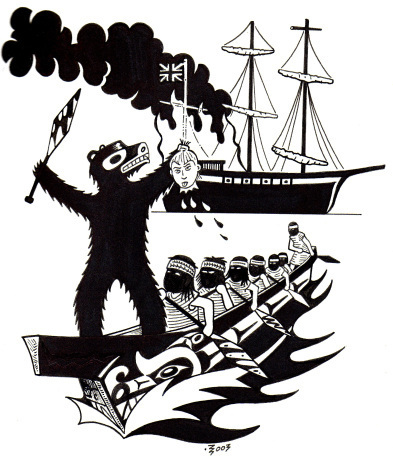
“If anyone is trying to destroy you, STOP HIM!” Karoniaktajeh – Louis Hall, Warrior’s Handbook p. 1
War & Colonization
Just slightly over 500 years ago, in 1492, three European ships under the command of Christopher Columbus arrived on the shores of what has come to be known as the Americas. With this began a genocidal war aimed at destroying Indigenous nations, occupying our ancestral territories, and plundering the natural wealth of the earth. How many tens of millions of Indigenous people were killed in this war will never be known, although the methods of massacres, biological warfare, executions, torture, and the enslavement of entire nations, has been well documented by historians.
Similar invasions were being carried out in Africa and parts of Asia during this same period. This systematic campaign of genocide and colonization was a total war waged against Indigenous nations by European colonialist nations. No one can deny this historical fact.
Colonization can be defined as the practise of invading other lands for the purpose(s) of settlement and/or resource exploitation. When the land is already occupied by another people, the result is usually war. In fact, colonialism occurs in a similar manner to many military conflicts between nations: there is a reconnaissance, an invasion, occupation, and then assimilation (the same methods can be seen in Iraq and Afghanistan).
War can be defined as, “a state of hostilities that exists between or among nations, characterized by the use of military force… a violent clash between two hostile, independent, and irreconcilable wills, each trying to impose itself on the other. “The means to that end is the organized application or threat of violence by military force.”Warfighting, p. 3Here in North America, military violence can be said to have characterized the imposition of colonialism & the establishment of settler-nations up to 1890. That year, 300 Indigenous men, women and children were massacred by US military forces at Wounded Knee, South Dakota. By the late 1880s, the use of gun-boats to destroy villages had ended along the Northwest Coast. In the southwest, Apache guerrillas had also been defeated. At this time, the military domination of Indigenous peoples was virtually complete. This was only slightly over 100 years ago.
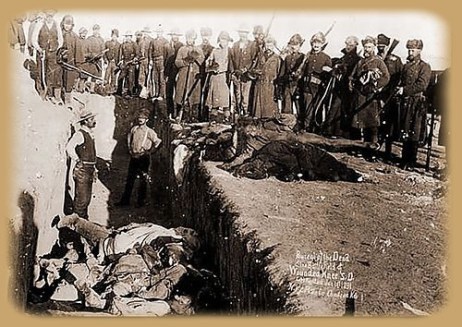 Mass grave at Wounded Knee, 1890; the massacre was carried out by the reformed 7th Cavalry
Mass grave at Wounded Knee, 1890; the massacre was carried out by the reformed 7th CavalryIs There A War Against Indigenous Peoples Today?
Today, there are some who believe that military force and violence does not characterize our present-day reality here in N. America. But this is not entirely correct: The selective use of military/police violence can be clearly seen in recent examples from the last 30 year period.
Thousands of soldiers and police, using military equipment, weapons and tactics, have been deployed against Indigenous movements and communities.
The most notable examples being:
• the 71-day siege at Wounded Knee, S. Dakota, in 1973. Hundreds of police, FBI and paramilitaries, with military assistance including armoured personnel carriers, weapons, ammunition, etc., engaged in fire-fights with warriors in bunkers and trenches. 2 warriors were shot & killed.
• the re-occupation of Ganienkah by Mohawks in New York state in 1974. Hundreds of state police laid siege, and gunfire was exchanged with white vigilantes. NY state eventually retreated & negotiated a parcel of land still occupied today.
• the blockade at Cache Creek, BC, in 1974.
• the re-occupation of Anicinabe Park near Kenora, Ontario, in 1974.
• the 1975 shoot-out at Oglala, S. Dakota (two FBI agents and one warrior killed). Hundreds of FBI agents were deployed to Pine Ridge in a massive search for AIM members.
• Restigouche, 1981: over 500 Quebec police raid the Mi’kmaq community of Restigouche, carrying out assaults & searches for ‘illegal’ fishing.
• the 77-day standoff at Kanehsatake (Oka) and Kahnawake, near Montreal, Quebec, in 1990. Over 4,500 Canadian soldiers were deployed. One SQ police officer was killed in an initial raid by a heavily-armed police tactical unit on Mohawk road-block, July 11.
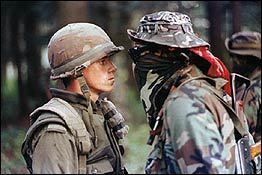 Kanehsatake/Oka 1990: a 77-day armed standoff between warriors and military.
Kanehsatake/Oka 1990: a 77-day armed standoff between warriors and military.• the month-long siege at Gustafsen Lake, BC (Ts’Peten), in 1995. Over 450 RCMP ERT members were used, with 9 Bison armoured personnel carriers from the Canadian military. During the siege, RCMP used an explosive charge to disable a vehicle, then rammed it twice with an APC. In a fire-fight which occurred, as many as 20,000 rounds were fired by police, yet only one defender was wounded (1 dog killed).
• the re-occupation at Ipperwash (Aazhoodeena), Ontario, 1995. A police tactical unit opened fire on unarmed protesters, killing Dudley George and shooting a 15-year old youth in back (1 dog killed).
• Burnt Church 2000-01. Hundreds of heavily armed DFO & RCMP officers (inc. ERT units) in boats, helicopters, & planes were used against Mi’kmaq lobster fishermen & security escorts (inc. Westcoast Warrior Society).
• July, 2001: over sixty RCMP were used to dismantle a road block at the Sutikalh re-occupation camp near Mt. Currie, BC. Along with a helicopter & dog teams, heavily-armed ERT members were used to arrest 7 (unarmed) people. The blockade had shut down all commercial traffic on Highway 99, a vital link between Vancouver & the southern interior.
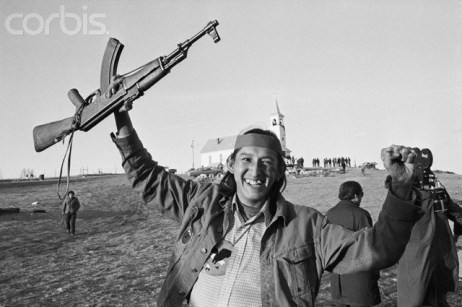 Wounded Knee, 1973
Wounded Knee, 1973• Sun Peaks (Skwekwekwelt), where RCMP arrested approx. 80 elders & NYM’ers from 2000-08. These arrests resulted from occupations, road-blocks, & protests against expansion of the Sun Peaks ski resort (near Kamloops, ‘BC’).
• September 21, 2002: RCMP from the Integrated Security Enforcement Team (INSET)—an anti-terrorist unit created after 9-11— along with ERT, raided homes of Westcoast Warrior Society members on Vancouver Island (BC).
• April 8, 2003: RCMP with ERT & helicopter raided NYM member homes in Bella Coola & Neskonlith (BC). They seized computers, discs, address books, & printed materials.
• October, 2003: a convoy of approx. 100 RCMP in over 30 large vehicles & vans, with ERT units, riot cops, and dog teams, rolled through Cheam as a show of force (Cheam had blockaded a CN railway cutting through their reserve in protest against logging in Elk Creek).
• June 27, 2005: over 30 Vancouver Police & RCMP (including ERT & INSET members) arrest 2 members of the Westcoast Warrior Society in Vancouver. They confiscate 10 rifles that had been legally purchased at Lever Arms. No charges are laid and the weapons kept as part of an ongoing investigation (shortly after, the WWS announces its disbandment).
• Spring, 2006: hundreds of Ontario Provincial Police are deployed against the Six Nations reserve near Caledonia, Ontario, after a housing development & highway are blockaded as part of a land reclamation. On April 20, police attempt to remove people from the reclamation site using batons & pepper spray but are forced back. This begins months of blockades and sabotage.
During these incidents & the time periods in which they occurred, hundreds of people were assaulted, arrested, and jailed. At least six Indigenous people died during these incidents; in S. Dakota, between 1973-1976, nearly 70 members/associates of the American Indian Movement (AIM) were killed by paramilitary groups & BIA police, acting under the direction of a corrupt tribal president, with the complicity of local, state, and US federal law enforcement agencies. FBI agents supplied training and equipment to these paramilitary & tribal police forces.
At roadblocks or re-occupation camps, heavily armed police ERT’s are also frequently used for surveillance and over-watch for regular police making arrests. When the Lil’wat road block at Mt. Currie was dismantled in the Fall of 1990, the large RCMP force which arrested over 60 people was covered by ERT snipers.
During a Spring 1995 road block near Merritt, BC, (Douglas Lake Ranch), an RCMP ERT unit was discovered conducting surveillance.
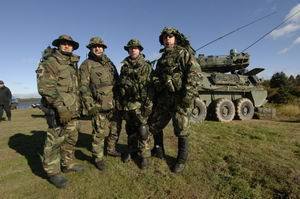 RCMP Emergency Response Team pose in front of Bison armored personnel carrier.
RCMP Emergency Response Team pose in front of Bison armored personnel carrier.In May 2001, near La Loche, Saskatchewan, an RCMP ERT unit was discovered conducting surveillance on a blockade camp. The camp was alerted to the presence of camouflaged police by a dog. After being confronted, they ran back to an old cabin, where other ERT members were brewing coffee. In their retreat, they left behind several items, including a tear gas canister and a 9 mm pistol.
Following September 11, 2001, and new anti-terrorist measures, the RCMP have become even more aggressive in their repression of Indigenous resistance. As noted, in September 2002, RCMP INSET & ERT units raided the homes of Westcoast Warriors. In April 2003, RCMP & ERT raided the homes of NYM members in Bella Coola & Neskonlith, BC. Then, in June 2005, the arrests of WWS members in Vancouver (after legally purchasing weapons) by INSET officers & ERT.
In 2006, a draft copy of the Canadian Forces new counter-insurgency manual included a description of the Mohawk Warrior societies as an example of domestic insurgents:
“The rise of radical Native American organizations, such as the Mohawk Warrior Society, can be viewed as insurgencies with specific and limited aims. Although they do not seek complete control of the federal government, they do seek particular political concessions in their relationship with national governments and control (either overt or covert) of political affairs at a local/reserve (‘First Nations’) level, through the threat of, or use of, violence.”
Because of Native protests, the CF removed the reference to warrior groups. Despite this, it is clear that the military continue to train and prepare for future domestic operations against Indigenous defenders.
Considering all this, it must be acknowledged that the use of military/police force, or the threat of violence by military/police force, has in fact continued, directed against and mostly limited to, those Indigenous people who become involved in protest or resistance activities.
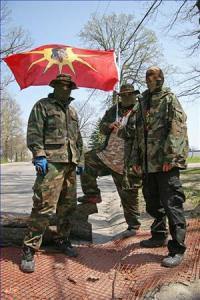 Tyendinaga Mohawks at blockade, Arpil 2008
Tyendinaga Mohawks at blockade, Arpil 2008Psychological Warfare
Because of the focused use of state violence against Indigenous resistance, some people believe these confrontations are the result of “extremists”, and that this use of military\police force is used only to resolve “criminal” matters.
This view reveals the success with which the state has isolated resistance, in the minds of some, as being the work of Indigenous “criminals” & “terrorists”, etc. In fact, after the 1990 Oka Crisis, an analysis of the siege concluded that the use of the military gave the Mohawk warriors a ‘moral victory’ in the eyes of the public. This was seen to contribute to widespread sympathy for the warriors across the country. One report recommended the use of heavily-armed police to reinforce the view of Indigenous rebels as “criminals.” This tactic was successfully used at Gustafsen Lake & Ipperwash in 1995 (along with strict control of the media).
Leonard Peltier, an Anishinabe-Lakota involved with AIM in the 1970s and imprisoned for over 30 years, has observed that,
“If white society’s attempts to colonize people meets with resistance, it is called war. However, if the colonized Indians of N. America unite to rise up and resist, then we are called criminals.”
Portraying resistance as “criminal” is a primary method by which our enemy seeks to undermine our movement. Other common smears include “terrorist,” “thugs,” etc. These terms carry negative & anti-social meanings. When attached to a group, terms such as these influence public perception & loyalties. Corporate media play a big role in disinformation campaigns & counter-insurgency operations.
War by other Means
Some may agree that the selective use of military force is used, but argue that this is the result of the imperfect society we live in. They might add that in other parts of the world, Indigenous people live with deadly violence on a daily basis. In N. America, we may be oppressed, but it is not a war, because military force is not used against our people as a whole.
This perspective, however, is based on a narrow definition of war, characterizing it as purely military. A broader definition of war states:
“War involves the use of all the elements of national power, including diplomacy, military force, economics, ideology, technology, and culture.”
Warfighting, p. 25
Wars can be of either high- or low-intensity, depending on the overall objectives & the means available to wage that war. By its very nature, because it is a struggle between two opposing wills, war is both uncertain and constantly changing. Because of these factors, different means of waging war will tend to dominate in certain conditions.
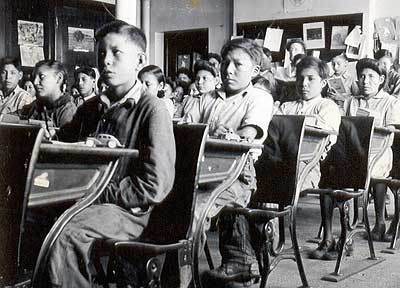 Native children in Residential School.
Native children in Residential School.Here in N. America, as our military ability to resist was overcome, other means besides a military one came to dominate colonialist strategies and methods. The suspension of military campaigns did not, however, mean the end of colonization.
Colonization is an ongoing and continual process that does not end so long as the territory and people are occupied by the colonialist nation. Just as war cannot be said to be purely a question of military force, neither can colonization. The imposition of special laws contained in the Indian Act, including the reserve and band council system; the residential school system and religious indoctrination; distorted and incomplete depiction’s of our people & history in the public education system, etc.; these are some examples of colonialism using legal, political, ideological, and cultural means.
Colonization is War
Colonization, the occupation of a territory and the domination of the Indigenous people, can be characterized as a clash between two forces, opposed to each other by their very nature, with one attempting to impose its will onto the other. It is a life & death struggle. This characterization fits our definition of war as previously stated.
It is therefore correct to say that colonization is a condition of war, and is it itself a form of war to gain territory for resources &/or settlement.
Because colonialism continues to this day, it follows then that a war is being waged against our people at this time. This war of colonization is conducted by the state of Canada using all the elements of national power at its disposal, including diplomacy, military/police force, economics, ideology, technology, and culture.
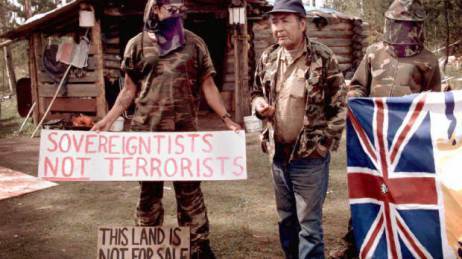 1995, siege at Ts'Peten (Gustafsen Lake) in south central interior of 'BC'.
1995, siege at Ts'Peten (Gustafsen Lake) in south central interior of 'BC'.Identifying The Effects Of This War And Combating Them
“There is another type of warfare waged on the native… It is waged against the mind of the natives. This type of warfare is every bit as dirty and deadly as the ones with guns. The casualties are the drunks, dope addicts & suicides. The casualty rate is high. There are Indians walking around dazed and confused suffering from identity conflict. This is one of the wars the modern… warriors have to fight. To fight any kind of war, one needs courage, gumption knowledge of the enemy and strategic planning. The biggest single requirement is FIGHTING SPIRIT.”
Louis Karoniaktajeh Hall, Warrior’s Hand Book, p. 10.
The more that a war of colonization comes to rely on political, economic or ideological means, and the less it uses military force, the more difficult it is for the Indigenous people to comprehend and understand that a war is in fact being waged against them.
In this way, the inferior condition of the Indigenous person in all aspects of life, and little progress towards remedying this oppressed condition, cannot be accounted for, except as an “unfortunate” result of history. Yet, despite continual inquiries and special commissions & constitutional debates & new government programs — all aimed at uplifting the Indigenous people, we are told — the fundamental conditions which keep Indigenous people oppressed do not change.
This lack of change is not due to history, it is because our enemy actively prevents any movement towards fundamental changes to its system. It in fact seeks to prevent even the thought that fundamental changes are necessary.
Ideology and psychological warfare, transmitted through the public education system, corporate media and entertainment industries, and political institutions, serves to obscure and make incomprehensible the full nature and extent of a war of colonization.
Know Your Enemy
Unable to comprehend this war, the Indigenous person is then incapable of defining an enemy and the means by which they are oppressed. This understanding can only come through education & consciousness. The identification of the colonial system as an enemy of Indigenous people must therefore be clearly communicated. Another important part of de-colonization is the history of Indigenous resistance to colonialism. As well, people need to be exposed to the realities of the global capitalist system, its use of military force to impose imperialism, the role of white supremacy & patriarchy in this process, etc.
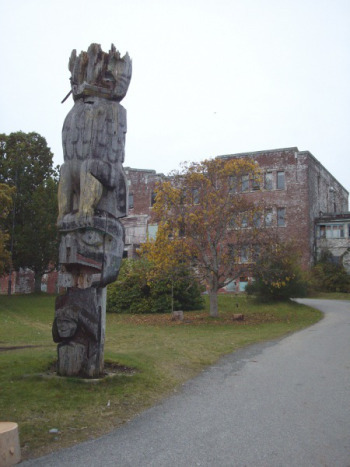 St. Michael's Residential School in Alert Bay, 2011
St. Michael's Residential School in Alert Bay, 2011Casualties of War
The effects colonization has had on our people must be acknowledged. Indigenous peoples have the highest rates of suicide in the country; the highest infant mortality rates; the lowest life expectancies; disproportionately high rates of AIDs, cancers, and imprisonment; the lowest income level; the highest unemployment rates, etc.
Many have suffered physical, mental and sexual abuse in the residential school system; the effects of this have resulted in inter-generational patterns of abuse in our communities. How many tens of thousands of Indigenous children have been taken from their families, and their people, and fostered out in non-Indigenous family units may never be known, and still continues.
The overall physical and psychological effects of these oppressed conditions can never be fully known, for the casualties and deaths of such a war do not appear as bodies on a battlefield, but instead as suicide statistics, alcoholics, drug addicts, prostitutes, and slaves. Many become apathetic to these conditions, while some attempt to assimilate themselves even further into this system and its way of life, a form of self-destruction in itself. Unable to see colonization as the fundamental condition which oppresses them, many not only lack a will to resist, they can even lack a will to live (i.e., disproportionately high rates of suicide among Native peoples).
Fighting Spirit
A primary aim of Indigenous resistance must be to strengthen the fighting spirit of our people and their will to resist. Fighting spirit can be strengthened and affirmed in many ways, i.e. through the use of certain language and concepts, graphics, clothing, crest animals, songs, etc. A fuller understanding and practice of our own Indigenous cultures would also contribute to raising fighting spirit, and in & of itself is a form of de-colonization. Our people’s history of resistance, and especially the last thirty year period, should be maintained and communicated.
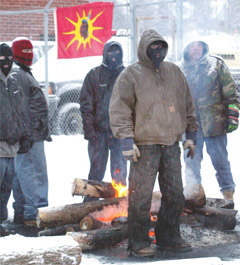 Masked warriors at Kanehsatake, 2004, after shutting down the police station.
Masked warriors at Kanehsatake, 2004, after shutting down the police station.
Conclusion
The purpose of this article has been to expose the reader to a view of colonization as a war for territory. It is believed that this view is critical to understanding the true nature of our struggle and the intentions, strategies, & tactics of our enemy.
That state security forces will be used to enforce colonial rule & corporate access to resources is an already established fact. As economic & environmental conditions decline, as resources become more depleted, the potential for ever-greater social conflict increases. For these reasons, fighting spirit must also be augmented by preparations for militant defense of land, resources, & communities, in the years to come.
[The chapter of the Indian Adoption Projects and ARENA are also part of this pattern of colonialism. We are living proof of what these governments did...Trace]
It is never too late to do the right thing (repost from 2022)
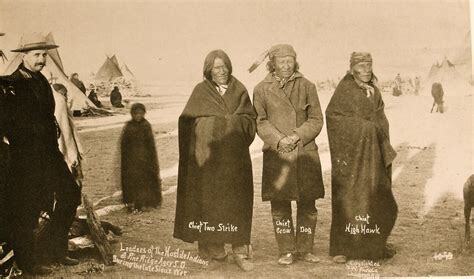 Photo and more background via
Photo and more background viaWounded Knee Repatriation Ceremony
November 5th in Barre, MA
11:00am - 5:00pm
When: Saturday, November 5, 2022; 1:00 – 3:00 PM Eastern
Where: Ruggles Lane Elementary 105 Ruggles Ln
Barre, MA
What: Native Organizers Alliance is organizing Harvard students and faculty to participate in a ceremony to commemorate the return of remains and artifacts stolen from the Wounded Knee massacre site. In the early 19th century, a traveling shoe salesman stole items from a gravesite at Wounded Knee in South Dakota. At the event, more than 131 items including moccasins, weapons, arrows, and clothing, will be returned to representatives of the Oglala Sioux and Cheyenne River Sioux Tribes.
Speakers will include
Kevin Killer, Oglala Lakota Tribe President
Nipmuc Chief Cheryll Toney Holley;
Chair of the Massachusetts Commission On Indian Affairs
Ann Meilus, Barre Museum Association Board President
Please sign up for transportation provided by the HKS Institute of Politics from Harvard to Barre, MA. On Saturday, November 5, we will leave at 11 am and return by 5 pm to Cambridge. The event is from 1 pm - 3 pm in Barre, MA.
Mass Grave
 Burial after the massacre of Wounded Knee. U.S. Soldiers putting Native Americans in mass grave. Photograph from wikipedia.org creative commons
Burial after the massacre of Wounded Knee. U.S. Soldiers putting Native Americans in mass grave. Photograph from wikipedia.org creative commonsQuestions? EMAIL: tracelara@pm.me
Massacre? Violence today?
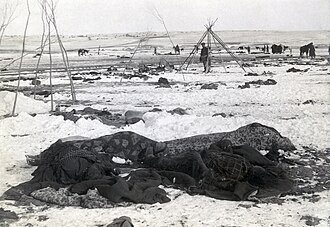 The aftermath of the Wounded Knee Massacre (Photo/Wikimedia Commons)
The aftermath of the Wounded Knee Massacre (Photo/Wikimedia Commons)
On Friday, the National Congress of American Indians (NCAI) pushed back on the U.S. Department of Defense’s (DoD) decision to retain the Medals of Honor awarded to soldiers involved in the Wounded Knee Massacre on December 29, 1890. This decision announced on Thursday disregards the well-documented truth of a brutal, unprovoked massacre carried out by the 7th Cavalry against the Lakota people—and ignores the moral obligation to confront past injustices with integrity.
Wounded Knee was not a “battle.” It was the deliberate mass killing of more than 350 unarmed Lakota men, women, and children who had sought refuge at Wounded Knee Creek. Contrary to Secretary of Defense Pete Hegseth’s claim that these medals are “no longer up for debate,” the event is widely recognized as a historical atrocity. This includes acknowledgment by historians, Tribal Nations, and even the U.S. Senate, which expressed its regret through Concurrent Resolution 153 in 1990. By preserving these medals, the DoD perpetuates the injustice and deepens the pain felt by the victims' descendants and Native communities across the country.
“Honoring those involved in the Wounded Knee Massacre with the United States’ highest military award is incompatible with the values the Medal of Honor is meant to represent,” said Larry Wright Jr., NCAI Executive Director. “Celebrating war crimes is not patriotic. This decision undermines truth-telling, reconciliation, and the healing that Indian Country and the United States still need.”
These medals should never have been awarded. In 2024, the DoD initiated a formal review of the medals, but despite decades of advocacy by tribal nations, historians, and members of Congress, this week’s announcement confirms the medals will remain. NCAI stands in solidarity with the Lakota Nations, Tribal communities, Native veterans, and active-duty service members—who serve the United States at higher rates than any other demographic—calling for the correction of the historical record and the alignment of our highest honors with our highest principles.
NCAI echoes the powerful voices of tribal leaders whose communities continue to bear the intergenerational trauma of this horrific event.
“Secretary Hegseth’s decision is another act of violence against our Lakota people,” said Chairwoman Janet Alkire, Standing Rock Sioux Tribe. “The Wounded Knee Massacre was an unprovoked attack on men, women, children and elders who had been rounded up by the military. As Indian people, we know what bravery and sacrifice means. We serve in the military at greater rates than any other group in the United States. I served in the Air Force with men and women who were brave and served with honor. The actions at Wounded Knee were not acts of bravery and valor deserving of the Medal of Honor. There is nothing Hegseth can do to rewrite the truth of that day.”
“The Wounded Knee Massacre was one of the darkest days in U.S. history,” added Chairman Ryman LeBeau, Cheyenne River Sioux Tribe. “The U.S. Cavalry stopped our people out on the high plains, surrounded them with guns and cannons, disarmed them, opened fire, and murdered them. Women and children were chased down and shot in the back. This is one of America’s darkest days and the medals must be revoked. They tarnish America’s Medals of Honor. There is no honor in murder. Secretary Pete Hegseth made this decision on his own concurrence with no contact or request for consultation to the Tribes.”
NCAI calls on the Department of Defense to immediately release the findings of the review that led to this deeply flawed and ahistorical decision. The DoD must reverse course and engage directly with NCAI and the leaders of the Great Plains Tribal Chairman's Association. In addition, we urge Congress to pass the “Remove the Stain Act” to ensure the Medal of Honor reflects true courage—not cowardice and cruelty—and that our nation’s history is preserved with honesty and respect.
This Massacre is often called the last Indian War... Trace
Look on the search bar for more on Wounded Knee...
Questions? EMAIL: tracelara@pm.meSeptember 27, 2025
If the colonizer didn’t write it, it didn’t happen, right?
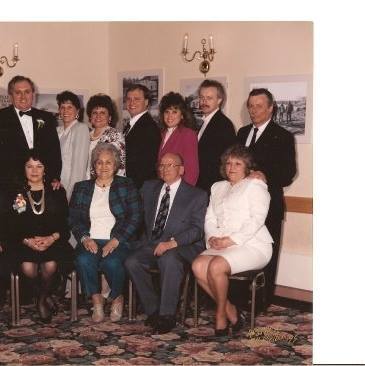 Mashantucket Pequot Tribal Chairman Skip Hayward (back row left) and his family in an early photo in Mashantucket (My photo)
Mashantucket Pequot Tribal Chairman Skip Hayward (back row left) and his family in an early photo in Mashantucket (My photo)By Trace Hentz (blog editor)
In 1999, when I took the Pequot Times editor job inConnecticut, I’d tried to read as much as I could find about New England “Indians”and especially the Mashantucket Pequot Tribal Nation. I’d found a book “The Spiritof New England Tribes” in a bookstore on the Cape, and fortunately I read itcover to cover before I took the job. Butit wasn’t enough and I knew that. Booksfor the general public were hard to find, and I think that was on purpose. “Weare not supposed to know,” and I have written that headline often. And it’s true.
If the colonizer didn’t write it (in books), it didn’thappen. Got it?
As part of our introduction to the tribe, when we are hired,we watch the film, THE WITNESS, at the Pequot Museum. It gives a glimpse of thehistory that lead to a massacre at Fort Mystick in the 1600s. It’s so hard toput into words but it was brutal and traumatic to watch, and then to comprehend. Killing women, children, and elders, shooting them as they tried to escape the burningfort, that was a wake-up call for me. What kind of monsters would do that?(Well, if you look up massacres, there are over 1000 documented in this placewe call America.) It’s something we are notsupposed to know.
Later I was asked to give a history talk for Foxwoodsemployees and most employees seemed (to me) to be clueless (but interested) in earlyhistory in this part of Connecticut. A lack of history causes suspicion andthat was the case with many people I met. They felt or said out loud, the Pequot werenot real “Indians.” Well, that was nottrue and it took a lot of writing and research in the Pequot Times every month to counter that falsehood. (I worked there5 years.) The only way to counter ignoranceis with TRUTH. So I searched and published“Genocide and Enslavement of the Pequot” by Dr. Kevin McBride, who was the directorof the Pequot Museum’s Research Center. I heard him give a talk at Yale andasked if I could publish it.
Just being here in New England, I could tell right away theyhide history, lots of it. It might upsetpeople, I guess? In 2000, I wrote apaper on Native slavery called “First Contact” and gave a short talk at the NativeAmerican Journalist’s conference in Florida. Many of the best Native journalists I knewwere surprised about the slavery part, but knew something about massacres.
Yes, in some tribes they do teach about colonization and first contact with non-Indians, slavery, massacres, but not all tribes.
Did you enjoy your history class in school? I remember theyfocused on the Nazis and Jews and world wars. Why didn’t we learn about American atrocity, starting in the 1600s right herein New England? What about Slavery?
I asked the research center to give me as much as they couldso I could publish it. As an editor, it’s our job to educate, offer news, and sneak in some realhistory when possible.
I call myself a citizen journalist now, and part-historian.I am still very interested in Native Slavery. My prayer was answered when I saw that BrownUniversity (in Rhode Island) had a presentation on this topic in June. Challenge yourself to keep learning, please.
Please click: www.stolenrelations.org (scroll downto see the June talk)
(To be continued)
Questions? EMAIL: tracelara@pm.meSeptember 23, 2025
Q&A with Quannah Chasinghorse - Narrator of The American Southwest
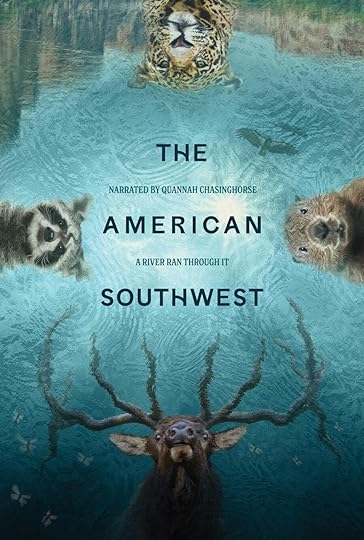
Go behind the scenes with Quannah Chasinghorse as she shares her experience narrating The American Southwest.
In this special Q&A, she reflects on her favorite scenes and what it meant to give voice to the wild places and stories of this iconic region.The American Southwest hit select theaters on September 5!
From the snowclad Rockies to the scorching Mojave desert, the Colorado River nourishes wildlife and sculpts the legendary landscapes. With narration by Quannah Chasinghorse, THE AMERICAN SOUTHWEST follows the river’s journey to sustain society and the natural world… through the lens of bugling elk, dam-building beavers, immigrant jaguars, and the region’s most fascinating wild characters.
To learn more https://theamericansouthwest.film
Questions? EMAIL: tracelara@pm.meSeptember 22, 2025
North Dakota releases first updated tribal textbook
North Dakota releases first updated tribal textbook, with more on the way By: Mary Steurer - September 16, 2025 5:00 am
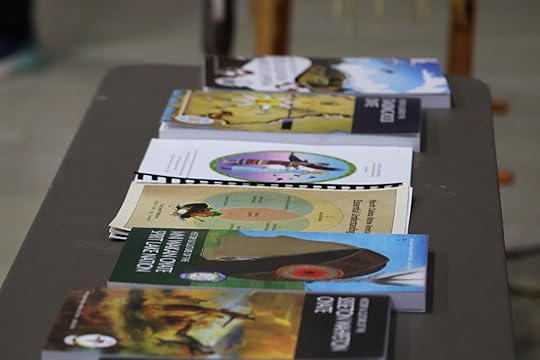
Display copies of updated tribal textbooks detailing the history and culture of the five Native nations that share land with North Dakota. (Mary Steurer/North Dakota Monitor)
The North Dakota Department of Public Instruction has released the first of a series of updated textbooks on the five Native nations that share land with North Dakota.
The book — titled “Journey to Understanding” — provides a brief introduction to the tribes’ history and culture. It’s the first time a new edition of the work has been released in more than two decades.
The textbook will soon be distributed to schools across the state, though a digital version is already available to download for free on the University of North Dakota’s Scholarly Commons website.
“Journey to Understanding” was first published in 2002 as cultural training material for social workers at the North Dakota Department of Human Services. The agency hired the Bismarck-based Native American Training Institute to write it to help its employees better understand the state’s Native communities.
Now, the Department of Public Instruction is promoting it as an educational resource for K-12 classrooms.
The agency will also soon release updated versions of four tribe-specific textbooks on the Standing Rock Sioux Tribe, Mandan, Hidatsa and Arikara Nation, Turtle Mountain Band of Chippewa and Spirit Lake Nation. Like “Journey to Understanding,” new editions of the books haven’t been published in more than 20 years.
The five books have long been considered leading sources for information on the tribes, and are referenced in K-12, college and professional settings, according to the Department of Public Instruction.
A first-ever textbook on the Sisseton-Wahpeton Oyate is also in the works.
The series is a collaborative effort between the state, the tribes, Native culture organizations and higher education institutions. The tribes and tribal colleges had full editorial oversight of the books’ content.
In addition to publishing all six books online, thousands of copies will be printed and distributed to schools across North Dakota.
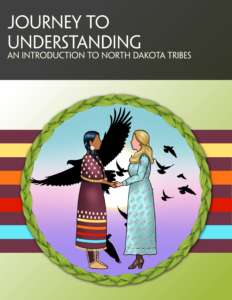 The cover of “Journey to Understanding,” a recently updated textbook on the history and culture of the five Native tribes that share land with North Dakota. The cover art is by Paula TopSky, a member of the Shoshone-Bannock Chippewa Cree. (Photo courtesy of the North Dakota Department of Public Instruction)
The cover of “Journey to Understanding,” a recently updated textbook on the history and culture of the five Native tribes that share land with North Dakota. The cover art is by Paula TopSky, a member of the Shoshone-Bannock Chippewa Cree. (Photo courtesy of the North Dakota Department of Public Instruction)“Journey to Understanding” is an ideal resource for anyone looking for a primer on the tribes, said Cheryl Ann Kary, executive director of Sacred Pipe Resource Center and the textbook’s author.
It covers topics including tribes’ status as sovereign nations, treaties and federal policies like the General Allotment Act, which reduced Native land ownership by distributing collectively owned tribal land to individual Native citizens.
The book also details some of the spiritual beliefs, values and traditions common to many tribes.
Kary, a citizen of the Standing Rock Sioux Tribe, said many North Dakotans could benefit from resources like “Journey to Understanding”. Many state leaders try to tackle complicated issues involving the tribes despite lacking basic knowledge about their communities, she noted. Kary compared this to trying to read poetry without first learning the alphabet.
“There’s so much just fundamental, foundational knowledge you have to know first before you can even talk about these complex issues,” she said.
While most of the content in the first and second edition of “Journey to Understanding” is the same, the latter version includes some new content as well. For example, it includes more information on the federal Indian Child Welfare Act of 1978, a federal law that protects tribes’ right to keep Native children in their communities, Kary said.
It also includes information on the North Dakota Native American Essential Understandings project, a collection of resources developed by tribal elders and educators to help K-12 North Dakotans learn about Native traditions.
The Department of Public Instruction expects to release the other five books in the series over the next several months.
It’s partnering with United Tribes Technical College and Sisseton Wahpeton Oyate Publishing to print the textbooks. Each K-12 school across the state will receive free copies of the books, with middle and high schools getting at least 25 sets of the series. Eventually, members of the public will be able to purchase their own copies.
Sashay Schettler, the Department of Public Instruction’s assistant director of Indian and multicultural education, said making the books available both online and in print will make it easier than ever for young North Dakotans to learn about the tribes.
“Honestly, it makes my heart happy,” Schettler, a citizen of the MHA Nation, said.
She noted the books can be a resource that helps schools comply with a state law adopted in 2021 requiring K-12 schools in North Dakota to teach Native American history.
The textbooks are the culmination of several decades of work by hundreds of people, according to a reflection on the revision process by state employees included at the end of “Journey to Understanding”.
The first editions of the books on the Standing Rock Sioux Tribe, the MHA Nation, Spirit Lake Nation and Turtle Mountain Band of Chippewa were spearheaded by Cheryl Kulas, former director of Native education at the Department of Public Instruction and an Oglala tribal citizen.
The agency hopes to facilitate revisions of the books every few years going forward, staff indicate in the reflection.
North Dakota Monitor reporter Mary Steurer can be reached at msteurer@northdakotamonitor.com.
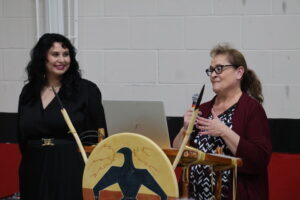 Sashay Schettler, left, and Lucy Fredericks present new editions of textbooks on the five tribes that share land with North Dakota at an April 10, 2025, reception. The original set of textbooks hadn’t received updates since their initial publication in the 1990s and early 2000s. (Mary Steurer/North Dakota Monitor)SOURCE: https://northdakotamonitor.com/2025/09/16/north-dakota-releases-first-updated-tribal-textbook-with-more-on-the-way/ Questions? EMAIL: tracelara@pm.me
Sashay Schettler, left, and Lucy Fredericks present new editions of textbooks on the five tribes that share land with North Dakota at an April 10, 2025, reception. The original set of textbooks hadn’t received updates since their initial publication in the 1990s and early 2000s. (Mary Steurer/North Dakota Monitor)SOURCE: https://northdakotamonitor.com/2025/09/16/north-dakota-releases-first-updated-tribal-textbook-with-more-on-the-way/ Questions? EMAIL: tracelara@pm.me
September 21, 2025
Manitoulin Island has forests, coasts, ancient tradition
The jingling of the bells becomes as loud as a waterfall, and that is her intention. The resonant jingle dance aims to imitate water and its healing power.
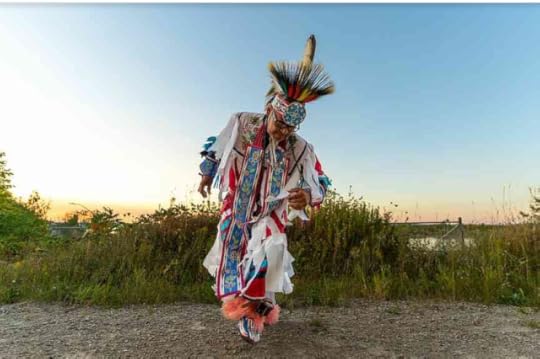 I have been to Manitoulin Island many times... If you can, please visit.
I have been to Manitoulin Island many times... If you can, please visit.The Canadian island is located in Lake Huron, one of North America's Great Lakes.
READ WHY: https://www.newstribune.com/news/2025/sep/14/canadas-manitoulin-island-has-forests-coasts/
Questions? EMAIL: tracelara@pm.meRobert Redford and George R.R. Martin Helped Bring 'Dark Winds' Into The World
Full Circle Moment:
Robert Redford’s Final Acting Role Features Iconic Chess Scene with George R.R. Martin
September 17, 2025
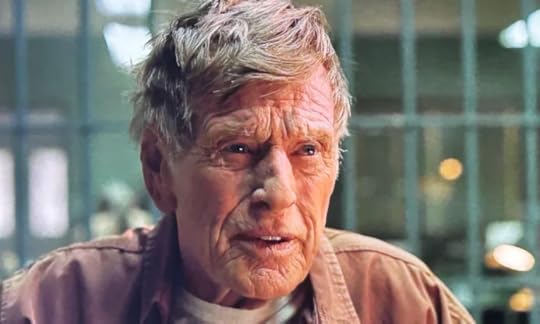 Robert Redford and George R.R. Martin Helped Bring 'Dark Winds' Into The World | Credit: AMC
Robert Redford and George R.R. Martin Helped Bring 'Dark Winds' Into The World | Credit: AMC Robert Redford’s final bow on screen arrived not with a bang, but a quiet, intense moment of strategy and silence: a chess game shared with none other than George R.R. Martin in AMC’s neo-Western series Dark Winds. This unexpected yet profoundly significant cameo, debuting in the season three premiere of Dark Winds in March 2025, was the brainchild of Martin himself, both men executive producers of the show.
Watching these two giants sit across a dimly lit jail cell, moving pieces on a chessboard, crystallizes an extraordinary convergence of talent and legacy. For Redford, who passed away on September 16, 2025, this was more than a final role; it was a full-circle moment in a career deeply intertwined with the stories of the American Southwest and authentic representation of Native American culture.
Redford’s final cameo in Dark Winds cements his enduring legacy, not just as an actor or director, but as a genuine ally who fought to bring Native voices to the forefront of cinema and television. His presence, brief yet profound, honors the stories he cherished and the people whose stories he wanted told truthfully.
Thank you Mr. Redford. Rest in Peace.
Questions? EMAIL: tracelara@pm.me6 Inuit teens go on a journey to connect with their past (Short version)
Remember this: It’s a stark reminder: Sometimes the best way to kill something and rob it of its history is to place it in a museum.
Meet six kids from a small community in the Arctic who felt disconnected from their Inuvialuit identity — until they went on a journey to connect with their past. The students teamed up with CBC Kids News to document a trip they took to see their ancestors' artwork and artifacts on display in museums across the country. They discovered a connection that runs deeper than they thought.
Questions? EMAIL: tracelara@pm.me
8 Indigenous films screening at TIFF, including Ni-Naadamaadiz: Red Power Rising
WOW!
This year’s Toronto International Film Festival features a record eight Indigenous films. One of the feature films, Ni-Naadamaadiz: Red Power Rising, tells the story of an Indigenous uprising in northern Ontario in 1975. Producer and co-writer Tanya Talaga discusses the importance of Indigenous films in truth and reconciliation.
Related An 'incredible bounty' of Indigenous films is lighting up Canadian festival screens Sagkeeng First Nation's Dana Solomon has 2 films at Toronto International Film Festival The 7 best, buzziest and most beautiful films at TIFF 2025 20 movies for book lovers to see at TIFF 2025 All the movies we're excited to see at TIFF 2025Questions? EMAIL: tracelara@pm.me
Trace A. DeMeyer's Blog
- Trace A. DeMeyer's profile
- 2 followers



